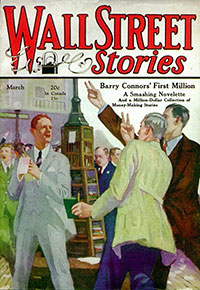 That also was true in the publishing world of the pulp era.
That also was true in the publishing world of the pulp era.
Eighty-five years ago this month, Dell Publishing Co. introduced Wall Street Stories, with a cover date of February 1929.
Today when someone says “Wall Street” and “1929,” we think “Black Friday” or “stock crash.” That wasn’t yet the case in January 1929.
It was still the Roaring ’20s when that debut number hit the newsstands. But by March worries over the high-flying stock market suddenly became real when there was a mini crash on March 25.
March 1929, coincidentally, was the date of the second issue of Wall Street Stories (above). It featured the lead novel “Barry Connors’ First Million” (by Alan Brener Schultz) and other stories, such as “Expensive Money” (by Rutherford Scott) and “Free Riders” (by N.D. Jones), and an article titled “How to Play the Market” (by John Donne).
March’s stock dive was quickly halted, but concerns were growing about the economy. Of course, by the fall things were worse, and on Friday, Oct. 24, 1929, panic hit the markets. And certainly by then no one was interested in reading about investors and speculators making it rich in stocks.
It would be almost a dozen years before another Wall Street-based pulp hit the newsstands. Street & Smith introduced The Wizard (later titled Cash Gorman) with the October 1940 number. It would last six issues, four more than Wall Street Stories.



